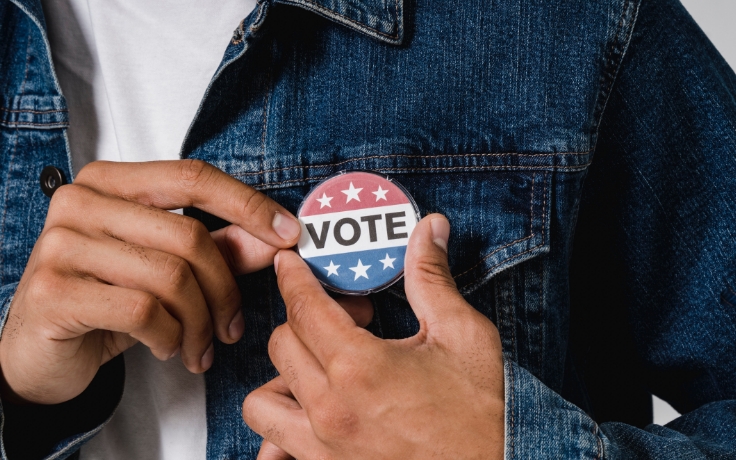AS THE 2020 CAMPAIGN NEARED ITS PEAK, both Joe Biden and Donald Trump began pouring millions of dollars into advertising and other efforts to reach Latino/a voters.
“We’re not taking anything for granted in this election,” Jennifer Molina, Biden’s Latino/a media director, told Politico. “The Latino vote is critically important.”
On the heels of those efforts, the Biden campaign turned its attention to Asian American and Pacific Islanders. It released a star-studded video just before Election Day encouraging them to vote. The video featured dozens of AAPI notables, including Mindy Kaling, Dwayne “The Rock” Johnson, Lucy Liu, Padma Lakshmi and Yo-Yo Ma. Kamala Harris, who is of South Asian descent, delivered the final message. It was simple. “When we vote, things change,” she said. “When we vote, we win.”
For Latino/a and Asian American voters, this was more than political rhetoric. Winning elections can bring change, not just in who holds office but also in the way California and the nation are governed.
According to the 2020 Census, Asian Americans and Latino/as were the fastest-growing among all racial and ethnic groups in the United States between 2000 and 2019. In California, the Asian American population rose by 25% to 5.8 million, while the Latino/a population grew by about 11% to about 15.5 million, or nearly 40% of the state’s 39 million residents. By comparison, the number of White people in the state decreased by 24%, the Census figures show.
“Because of immigration, new Latino and new Asian American voters are being added in every election cycle,” said Natalie Masuoka, an associate professor of political science and Asian American studies at UCLA and author of the book Multiracial Identity and Racial Politics in the United States.
“This is an amazing American democracy story,” Masuoka said in an interview. “The two largest immigrant groups in the country are literally adding new voters.”
Historically, influxes of new voters, such as European immigrants in the late 1800s to early 1900s, or Blacks after emancipation, have re- shaped the American political landscape. This time, it’s Asians and Latino/as. While these new voters are increasingly showing how they can effect change, the full impact of Asian Americans and Latino/as has yet to be felt.
When it is, the influence on governance is likely to be strong.
The first step: voting
FIRST, LATINO/AS AND ASIAN AMERICANS must cast ballots. In California, 8.3 million Latino/as and almost 4 million Asian Americans were eligible to vote in 2020, but just 60.4% of Latino/as and 62.9% of Asian Americans registered to vote, according to a new UCLA report by the Latino Policy and Politics Initiative. By comparison, 78.2 % of eligible Whites registered. For Blacks, it was 68.1%.
When it came to actually voting, the report found, the percentages dropped further: Latino/as 54.7%; Asians 59.9%; Blacks 64%; and Whites 74.5%.
Latino/as were the only demographic group in California whose registration and voting rates were more than 10 percentage points below national averages, while Asian Americans had the second-lowest registration and turnout rates. Non-Hispanic Whites were the only group in the state with a higher registration and turnout rate than the national average, according to the study.
“For Latino and Asian groups, there’s a gap in mobilization, a gap in investment to mobilize Latino and Asian voters and capture the diversity within their communities in a culturally competent manner in order to get more Latino and Asian voters to register and to show up at the polls,” said Rodrigo Domínguez-Villegas, director of research at LPPI, who authored the report.
Latino/a and Asian American voters have been seen by both political parties largely as monoliths, but their diversity is well documented. In California, as in the rest of the country, most Latino/a voters have tended to side with Democrats, but that affiliation varies by election cycle and by candidate and issue. Even Trump, who famously derided Mexican immigrants as rapists and murderers, won the support of about a third of Latino/a voters in 2020.
Moreover, racial classifications themselves are transforming. The 2020 Census shows that about 33.8 million people now identify as multiracial, in contrast to about 9 million a decade ago — a 276% increase.
“What’s amazing about California politics is the growing political power of Asian American and Latino voters at the individual level — not thinking about Asian American and Latino voters as a homogeneous group — and the growing realization from all Californians that these new waves of electorates really can shift voting outcomes,” said Masuoka, who co-authored a separate study that tracked racial differences in voting on 12 statewide propositions on the 2020 California ballot.
Although political consultants may still see these voters as monoliths, the findings of that study dispel notions of a homogeneous Asian vote or Latino/a vote, while showing that external regional factors and campaign messaging played a role in the outcome of these measures.
“What was striking about what we learned from looking at the analysis from across California is that there is a lot of important regional variation, with Bay Area voters of all races voting in favor of more liberal positions on propositions than in Los Angeles and portions of Southern California,” Masuoka said. “Even though we think about our big cities as being the most liberal areas, we were showing that within California there are important regional variations.”
This geographical impact on voting was notable, for example, on an affirmative action measure, which demonstrated not only a region- al variation but also a racial one. Proposition 16 called for the repeal of 1996’s Proposition 209, which changed the state constitution to prohibit state government and public institutions from considering race, sex, ethnicity or national origin in public employment, education and contracting.
“We were struck by the amount of heterogeneity on affirmative action,” Masuoka said. “That speaks to the important role political geography continues to play in state politics. Where Asian American and Latino voters live appears to impact how they vote on policy issues.”
The study also found that voters of color can influence election results when White voters are split in their preferences, and that coalition voting between two racial groups also can have an impact: “When one racial minority group votes with White voters, they affect the level of competitiveness in an election.”
In addition, the findings provided insight into the effects of political organizing and voter education.
Proposition 22, the gig economy ballot initiative to classify rideshare and delivery drivers as independent contractors rather than employees, showed strong uniformity among voters of all races. A record-setting $204 million was spent on Proposition 22, with the bulk of contributions — nearly $189 million — coming from companies such as Uber, Lyft and DoorDash, while opposition came from labor unions. The proposition passed.
“Perhaps voters aren’t necessarily voting on their actual ideological or political position on these issues, but they’re strongly influenced by various interest groups that are able to create a framing that is compelling and can influence the ultimate outcome,” Masuoka said. “The outcome on Proposition 22 would suggest that when something was really highly funded and really well campaigned, the outcome was relatively more uniform.”
Mobilizing communities
Big money certainly isn’t the only means of delivering a vote. Both Masuoka and Domínguez-Villegas say that trusted messengers, such as community organizations, churches and area small businesses, can be effective in helping to educate and inform new voters.
“Among Latinos, the majority speak either English or Spanish or both, but there’s a considerable number of Latinos that do not speak either English or Spanish; they speak languages that are indigenous to Mexico or Guatemala or Honduras or El Salvador. These groups are culturally and religiously diverse — especially Asians,” Domínguez-Villegas said in an interview. “It’s important that political parties and state officials and county officials in charge of organizing elections and mobilizing voters take a more comprehensive and inclusive approach to these two groups.”
Many new voters, particularly first-generation immigrants, come from countries where the political system is unlike that o f the United States; so there are varying degrees of familiarity with the U.S. electoral system, Domínguez-Villegas said. Providing additional levels of voter education may be seen as costly and time-consuming. And even when attempts are made to educate voters on why they should vote for a particular candidate or proposition, those efforts often occur at the last minute.
During the 2021 bid to recall Gov. Gavin Newsom, for example, recall backers cited the governor’s support of sanctuary status and other policies regarding undocumented immigrants among reasons to vote him out. But that same issue spoke to many Latino/a voters in a different way, and late efforts to mobilize voters helped secure Newsom’s victory.
“Once that mobilization started with on-the- ground partners and organizations explaining to the Latino voters what was at stake if Newsom was ousted from the governor’s office, it didn’t take much for Latino voters to understand, ‘Hey, there’s a lot at stake,’” Domínguez-Villegas said. “A lot of them showed up, and over 80% of Latino voters voted for Newsom to stay.”
This afterthought attitude, he said, stems from political parties mistakenly seeing Latino/as and Asian Americans as non-voters and thus failing to invest in efforts to bring them in.
According to a study by the Pew Research Center, 84% of eligible voters said they were contacted by a candidate’s campaign or by a group supporting a candidate in at least one of six ways during the month before the November 2020 election. Of that group, 74% of English-speaking, eligible Asian voters and 75% of eligible Hispanic voters said they were contacted, in contrast to 87% for Whites and 82% for Blacks.
“Over and over, we’ve seen examples where, if and when political parties invest in actually producing campaign materials in the different languages that the different groups speak, and actually mobilize and get on the ground and talk to voters, then people register and vote,” Domínguez-Villegas said.
The LPPI study provided insight into where the gaps exist in voter participation, which will allow campaigns to find ways to encourage people to participate in the election process and ensure their voices and needs are heard, he said.
“We think that the right to vote for everybody is equal. Therefore, everybody should have access to the same information in the same way as every other voter.”
On language
THE FEDERAL VOTING RIGHTS ACT requires that in counties where more than 10,000 people, or 5% of the population, speak a language other than English, election materials and ballots in that language must be provided. But this doesn’t ensure that voting will take place.
“You might be able to read it in your native language, but do you understand how this fixes or changes existing law?” Matsuoka said. “That goes back to an education issue.
“Upholding the Voting Rights Act is something that is under serious, serious attack,” she said. “Over the last few years, there has been a slow reversal of different items in the Voting Rights Act, which basically barred discrimination in access to the ballot box. We are heading into a very scary period where we are worried now that the Voting Rights Act is something that will no longer exist for us.”
That battle may eventually become part of voter education and mobilization. Change comes, Domínguez-Villegas said, when there is sustained engagement of voters and educational outreach. But, as his report shows, more needs to be done.
Currently, non-Hispanic White Californians make up 37% of the state’s population and ac- count for 54% of the state Assembly and Senate. Latino/as comprise about 39% of the population and 25% of the state Legislature. Asian and Pacific Islanders are 15% of the population, with 12% representation in the Legislature. For African Americans, there is near parity: 7% of the population and 8% representation.
“Given that the state is becoming more diverse, we need to figure out ways to make sure that these groups are able to elect people who represent them,” Domínguez-Villegas said. “What’s needed are policies that would allow these groups to fully participate in electoral politics in the state so those populations are reflected in the elected officials making decisions for all Californians.”

























